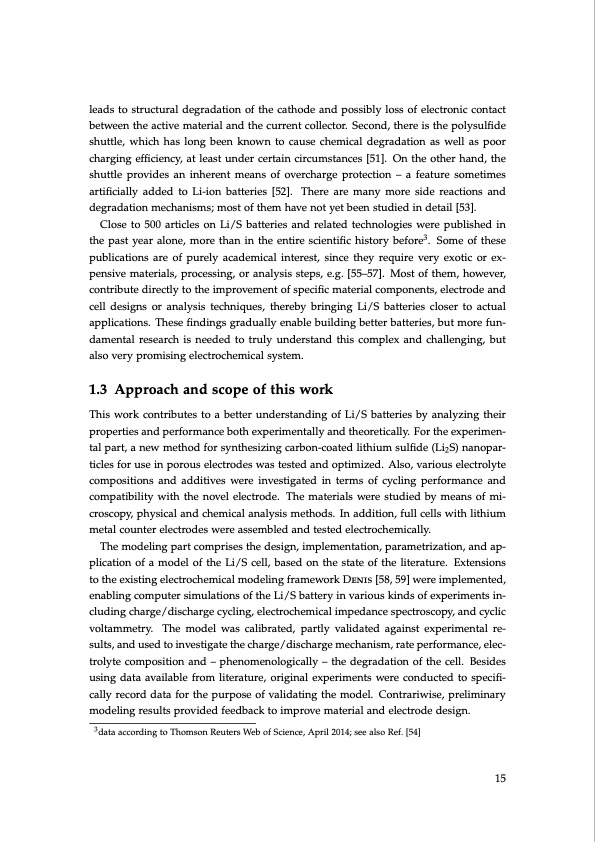
PDF Publication Title:
Text from PDF Page: 015
leads to structural degradation of the cathode and possibly loss of electronic contact between the active material and the current collector. Second, there is the polysulfide shuttle, which has long been known to cause chemical degradation as well as poor charging efficiency, at least under certain circumstances [51]. On the other hand, the shuttle provides an inherent means of overcharge protection – a feature sometimes artificially added to Li-ion batteries [52]. There are many more side reactions and degradation mechanisms; most of them have not yet been studied in detail [53]. Close to 500 articles on Li/S batteries and related technologies were published in the past year alone, more than in the entire scientific history before3. Some of these publications are of purely academical interest, since they require very exotic or ex- pensive materials, processing, or analysis steps, e.g. [55–57]. Most of them, however, contribute directly to the improvement of specific material components, electrode and cell designs or analysis techniques, thereby bringing Li/S batteries closer to actual applications. These findings gradually enable building better batteries, but more fun- damental research is needed to truly understand this complex and challenging, but also very promising electrochemical system. 1.3 Approach and scope of this work This work contributes to a better understanding of Li/S batteries by analyzing their properties and performance both experimentally and theoretically. For the experimen- tal part, a new method for synthesizing carbon-coated lithium sulfide (Li2S) nanopar- ticles for use in porous electrodes was tested and optimized. Also, various electrolyte compositions and additives were investigated in terms of cycling performance and compatibility with the novel electrode. The materials were studied by means of mi- croscopy, physical and chemical analysis methods. In addition, full cells with lithium metal counter electrodes were assembled and tested electrochemically. The modeling part comprises the design, implementation, parametrization, and ap- plication of a model of the Li/S cell, based on the state of the literature. Extensions to the existing electrochemical modeling framework Denis [58, 59] were implemented, enabling computer simulations of the Li/S battery in various kinds of experiments in- cluding charge/discharge cycling, electrochemical impedance spectroscopy, and cyclic voltammetry. The model was calibrated, partly validated against experimental re- sults, and used to investigate the charge/discharge mechanism, rate performance, elec- trolyte composition and – phenomenologically – the degradation of the cell. Besides using data available from literature, original experiments were conducted to specifi- cally record data for the purpose of validating the model. Contrariwise, preliminary modeling results provided feedback to improve material and electrode design. 3data according to Thomson Reuters Web of Science, April 2014; see also Ref. [54] 15PDF Image | Lithium-Sulfur Battery: Design, Characterization, and Physically-based Modeling

PDF Search Title:
Lithium-Sulfur Battery: Design, Characterization, and Physically-based ModelingOriginal File Name Searched:
Dissertation_David_N._Fronczek_The_Lithium_Sulfur_Battery.pdfDIY PDF Search: Google It | Yahoo | Bing
Sulfur Deposition on Carbon Nanofibers using Supercritical CO2 Sulfur Deposition on Carbon Nanofibers using Supercritical CO2. Gamma sulfur also known as mother of pearl sulfur and nacreous sulfur... More Info
CO2 Organic Rankine Cycle Experimenter Platform The supercritical CO2 phase change system is both a heat pump and organic rankine cycle which can be used for those purposes and as a supercritical extractor for advanced subcritical and supercritical extraction technology. Uses include producing nanoparticles, precious metal CO2 extraction, lithium battery recycling, and other applications... More Info
| CONTACT TEL: 608-238-6001 Email: greg@infinityturbine.com | RSS | AMP |